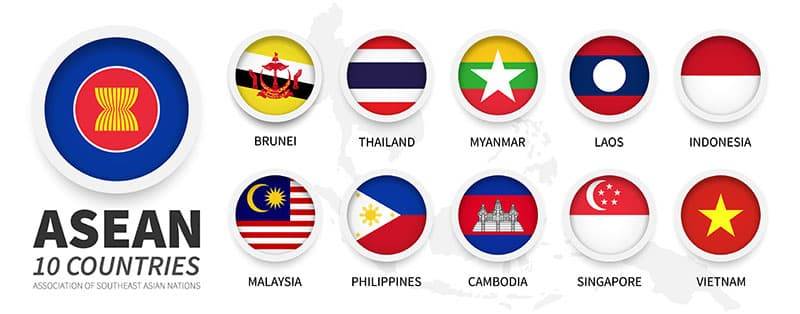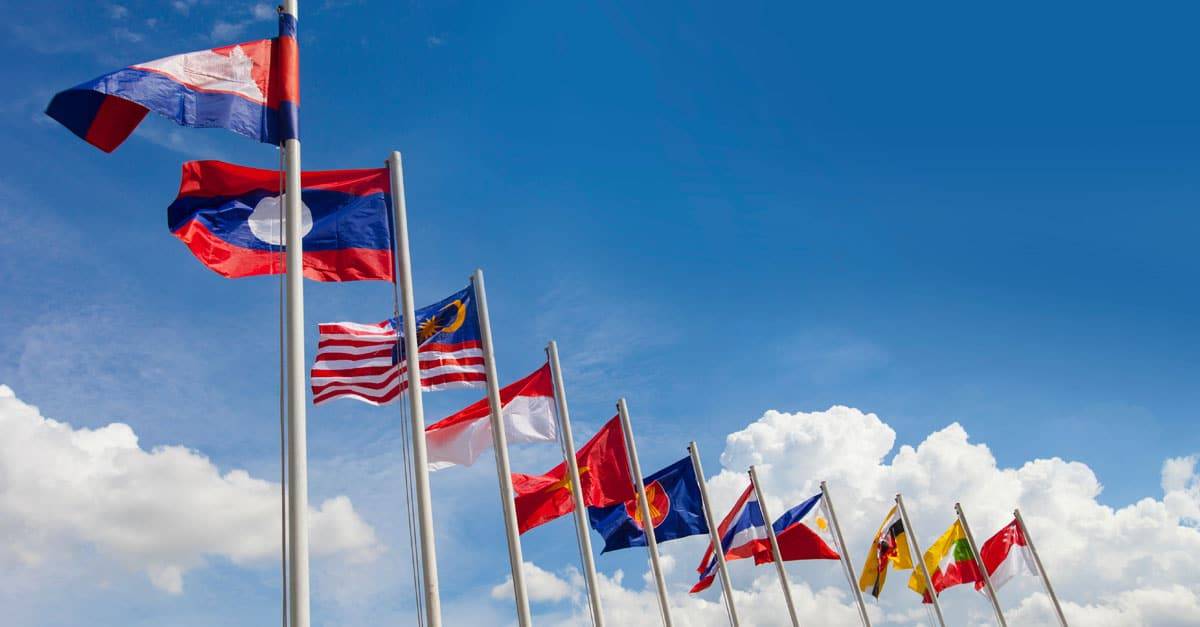
As the global economic axis shifts eastward, the Asia-Pacific area, which includes the ASEAN group, emerges as a hotspot for wealth accumulation. The region is quickly becoming a haven for a growing population of UHNWIs and HNWIs, individuals whose net worth reflects the region’s booming economic landscape. The trajectory of wealth growth in this region is more than a statistical marvel; it’s a story about how economic synergies generated by the ASEAN Economic Community are creating fertile ground for wealth production and investment ventures.
This article seeks to travel through the nuanced paths of how the ASEAN Economic Community is changing the wealth and investment landscape for UHNWIs and HNWIs in order to present a thorough insight on the subject.
A Stable and Competitive Economic Region
The Association of Southeast Asian Nations (ASEAN), established on August 8, 1967, serves as a regional intergovernmental organisation comprising ten countries in Southeast Asia, promoting intergovernmental cooperation and facilitating economic, political, security, military, educational, and sociocultural integration among its members and other Asian states. It’s a powerful player in the international arena, with its cumulative economic clout placing it as the third-largest economy in Asia and the fifth-largest in the world. The ASEAN Economic Community (AEC), a major milestone in the regional economic integration agenda, aims to transform ASEAN into a region with free movement of goods, services, investment, skilled labour, and a freer flow of capital, making it a highly competitive and globally integrated region with equitable economic development.
The ASEAN Economic Community (AEC) has made significant progress towards developing a stable and competitive economic zone that is critical to the financial interests of UHNWIs and HNWIs. The following are some significant developments and their implications:
Wealth Aggregation: Simple, Dynamic, and Secure Beyond Compare. Discover the Altoo Wealth Platform!
Free Flow of Goods, Services, and Investments
The AEC’s goal of building a single market and manufacturing base is critical to improving the free flow of commodities, services, and investments. This programme aims to liberalise and facilitate trade, which will help attract foreign direct investments to the region. The ASEAN region remains appealing for foreign direct investments, and this trend is projected to continue throughout the year.
Intra-ASEAN merchandise trade increased by 17.3% between 2012 and 2021, indicating increased interconnection among ASEAN states. This increase in commerce demonstrates the economic region’s rising stability and competitiveness.
Reduced Socioeconomic Disparities and Poverty
One of the AEC’s main goals is to promote equitable economic development. The AEC intends to reduce socioeconomic gaps and relieve poverty across member countries by developing a common market and production base.
The ASEAN region’s economic diversification, as a key producer in a variety of industries such as agriculture, mining, consumer products, and technological services, is a strategic asset that contributes to the reduction of socioeconomic gaps. This diversity, combined with the largest free trade area in terms of GDP coverage as of February 2023, highlights the ASEAN region’s competitive advantage.
The ASEAN Economic Community’s continued efforts to strengthen economic integration and trade liberalisation are creating a fruitful environment for UHNWIs and HNWIs. Progress in lowering socioeconomic disparities not only strengthens the region’s stability but also opens up a myriad of investment opportunities, making it an appealing location for HNWIs.
Fostering a Highly Integrated and Cohesive Economy
The ASEAN Economic Community (AEC) is gradually paving the way for a highly linked and cohesive economy, a venture that has significant promise for UHNWIs and HNWIs, as well as their skilled managers. Here are the key steps in this direction:
Enhanced Connectivity and Sectoral Cooperation
The ASEAN Connectivity Coordinating Committee (ACCC), for example, is helping member countries improve their connectivity. Discussions during a recent conference on February 21, 2023, focused on the implementation of the Master Plan on ASEAN Connectivity (MPAC) 2025, which demonstrates an organised approach to creating improved connectivity across the region.
Sectoral collaboration is a priority, with events such as the ASEAN Energy Business Forum 2023 emphasising “Accelerating Energy Connectivity to Achieve ASEAN’s Sustainable Growth.”
Furthermore, in October 2023, the ACCC hosted a workshop with over 110 participants from several sectoral bodies to develop open communication and address connectivity challenges.
Promotion of a Competitive, Innovative, and Dynamic ASEAN
The AEC 2025 blueprint reflects ASEAN’s aim to be competitive, innovative, and dynamic. It emphasises the significance of increased connectivity and sectoral cooperation in order to achieve a resilient, inclusive, and globally prominent ASEAN.
The ASEAN Economic Community’s aggressive activities are laying the groundwork for a highly integrated and cohesive economy. ASEAN is becoming more competitive, creative, and dynamic thanks to its focus on better connectivity and strong sectoral collaboration. It may also offer a variety of investment opportunities for UHNWIs and HNWIs that fit their financial goals.
The ASEAN Economic Community (AEC) is establishing a stable and fertile ground for wealth accumulation and investment opportunities. The conducive environment is expected to be a significant draw for both UHNWIs and HNWIs, offering them unique advantages to grow and manage their wealth.
AEC’s Role in Wealth and Investment Landscape
The ASEAN Economic Community (AEC) is laying the groundwork for a stable and productive environment for wealth generation and investment opportunities. The favourable climate is projected to be a major draw for both UHNWIs and HNWIs, providing them with unique opportunities to grow and manage their money.
Favourable Conditions for Wealth Accumulation
The increased economic resilience and potential expansion of ASEAN’s wealth management sector are expected to inject new assets under management (AUM) and create new wealth. Additional investment and trade into ASEAN are likely to widen the scope of wealth management, offering additional chances for private banks to serve HNWIs.
Creation of Investment Opportunities
The ASEAN area, notably Indonesia, with its abundant natural resources and large domestic market, is expected to draw major foreign and local investment. The investment objective for 2023 is set at US$92 billion, making it a long-term investment hub.
Despite a drop in FDI in 2020, ASEAN remains an appealing investment destination, showing a solid investment landscape that can potentially offer attractive opportunities for UHNWIs and HNWIs.
UHNWI’s continued interest in areas such as healthcare, logistics/industrial, and real estate demonstrates the diverse investment opportunities accessible in the ASEAN region. For example, one in every five UHNWIs plans to invest directly in 2023, with 13% seeking for indirect opportunities, highlighting the region’s appeal as an oasis for diversified assets in the face of economic uncertainty.
The Broader Implications
The actions of the ASEAN Economic Community have laid the groundwork for sustained economic growth and prosperity in the ASEAN area, raising its position on the world financial map. This synergy demonstrates the power of regional collaboration and strategic economic planning in creating an environment conducive to wealth creation and investment opportunities.
Sustained Economic Growth and Prosperity in the ASEAN Region
Despite the challenges faced by the transition in global demand from commodities to services and tighter monetary regulations, the ASEAN area remains a key driver of global economic growth, with a forecast growth rate of 4.6% in 2023, up from 3.9% in 2022. The region’s strategy to capitalise on environmental and social development goals has aided economic resilience by aligning with global sustainability agendas and creating inclusive growth. Furthermore, the importance of international project finance in the ASEAN region highlights the critical significance of foreign investments in accelerating economic growth and development.
Positioning of ASEAN on the Global Financial Map
The ASEAN region’s appeal to foreign direct investment has grown, with trends in commercial and state investment maintaining stability, confirming its appealing investment landscape. ASEAN economies are strengthening their resilience against a variety of threats, including potential pandemics, geopolitical instability, and climate change, which in turn strengthens the region’s financial status on the world stage. ‘ASEAN Matters: Epicentrum of Growth,’ the subject of Indonesia’s ASEAN Chairmanship in 2023, encompasses the strategic focus on recovery, digital economy, and sustainability, with the goal of positioning ASEAN as an anchor of global economic stability.
This changing economic landscape provides a fertile field for UHNWIs and HNWIs, providing an abundance of investment opportunities while contributing to the ASEAN region’s overall economic success. The activities, wealth creation, and investment opportunities of the ASEAN Economic Community are all linked to each other. This creates a positive cycle of economic growth and global financial recognition.
The ASEAN Economic Community (AEC) is very complicated, but it tells an interesting story of how economies have come together, people have become rich, and investment trends have changed among ultra-high net worth and high net worth people in the Asia-Pacific region. The unflagging efforts of the AEC to maintain a stable, competitive, and cohesive economy have cultivated an environment that is favourable to the accumulation of wealth, particularly among UHNWIs and HNWIs.



